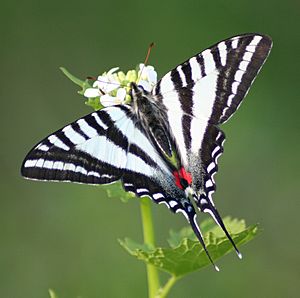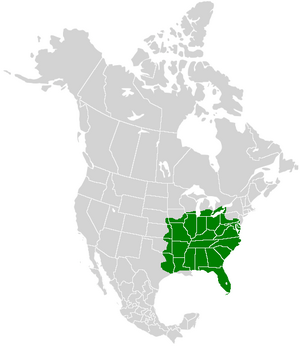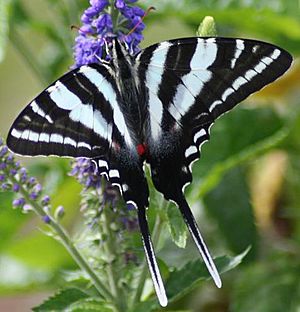Zebra swallowtail facts for kids
Quick facts for kids Zebra swallowtail |
|
|---|---|
 |
|
| Spring form | |
| Conservation status | |
| Scientific classification | |
| Genus: |
Protographium
|
| Species: |
marcellus
|
 |
|
| Synonyms | |
|
|
The zebra swallowtail (scientific name: Protographium marcellus) is a beautiful swallowtail butterfly. It lives in the eastern United States and southeastern Canada. This butterfly is special because it's the state butterfly of Tennessee.
It's easy to spot a zebra swallowtail! It has a unique wing shape with long tails. Its black and white stripes look just like a zebra. These butterflies love pawpaw trees. You will usually find them close to these trees. Young zebra swallowtails, called caterpillars, eat pawpaw leaves. Adult butterflies drink nectar from flowers. They also get minerals from wet soil.
Contents
What Does the Zebra Swallowtail Look Like?
The zebra swallowtail has a wingspan of about 6.4 to 10.4 cm (2.5 to 4.1 in). Its wings are shaped like triangles. They are white or greenish-white with black stripes. Two long, sword-like tails grow from its back wings.
The back wings have two blue spots near the corner. There is also a red spot close to the butterfly's body. A red stripe runs down the middle of the underside of the back wing.
Spring and Summer Forms
Zebra swallowtails have two different looks depending on the season.
- Spring forms are smaller and whiter. They have short, black tails with white tips.
- Summer forms are bigger. Their black stripes are wider. They also have longer, black tails with white edges.
When Do Zebra Swallowtails Fly?
You can see these butterflies flying at different times of the year. In the northern parts of their home, they fly from late March to August. In the southern parts, they fly from February to December.
They have two groups of babies, called broods, in the north. In the south, they have three to four broods. The first group of butterflies to hatch is usually the largest.
How Do Zebra Swallowtails Behave?
Male butterflies fly quickly near pawpaw trees. They are looking for females. They usually fly about 0.5 to 1.8 meters (2 to 6 feet) above the ground. Females fly slowly when they are searching for good places to lay eggs.
Both male and female butterflies love to visit flowers. They get nectar from many different kinds of plants. Males also gather on wet sand or soil. This is called puddling. They do this to get salts and special nutrients. These nutrients help the males with reproduction. Sometimes, they also eat rotting fruit or drink from animal urine.
The Zebra Swallowtail Life Cycle
Female butterflies lay their eggs one by one. They place them on pawpaw leaves or on the tree trunks. This is because young caterpillars can sometimes eat each other.
The eggs are round and pale green. They turn orange-brown as they get older. When caterpillars are young, they are black with light-colored stripes. As they grow, they can have two different colors.
- The most common color is green with yellow and white stripes.
- A rarer color is black with white and orange bands.
Both types of caterpillars have a special band between their chest and belly. This band is yellow, black, and bluish-white. The caterpillar also has a yellow, smelly, forked gland called an osmeterium. It uses this gland to scare away predators like spiders and ants.
The chrysalis (the pupa stage) can be green or brown. It is more compact than other butterfly chrysalises. It has three small horns on its head and chest. If winters are cold, the chrysalis will hibernate until spring.
- Life cycle
What Do Zebra Swallowtail Caterpillars Eat?
Zebra swallowtail caterpillars only eat plants from the Asimina genus. These plants are commonly known as pawpaws. Some types they eat include:
- A. angustifolia (slimleaf pawpaw)
- A. incana (woolly pawpaw)
- A. parviflora (smallflower pawpaw)
- A. reticulata (netted pawpaw)
- A. tetramera (four-petal pawpaw)
- A. triloba (common pawpaw)
The caterpillars take in special chemicals called acetogenins from these pawpaw plants. These chemicals stay in the caterpillar's body and even in the adult butterfly. This might help protect the butterfly from birds that try to eat them.
- Edwin Möhn, 2002 Schmetterlinge der Erde, Butterflies of the world Part XIIII (14), Papilionidae VIII: Baronia, Euryades, Protographium, Neographium, Eurytides. Edited by Erich Bauer and Thomas Frankenbach Keltern: Goecke & Evers; Canterbury: Hillside Books. ISBN: 978-3-931374-87-7 All species and subspecies are included, also most of the forms. Several females are shown the first time in colour.









